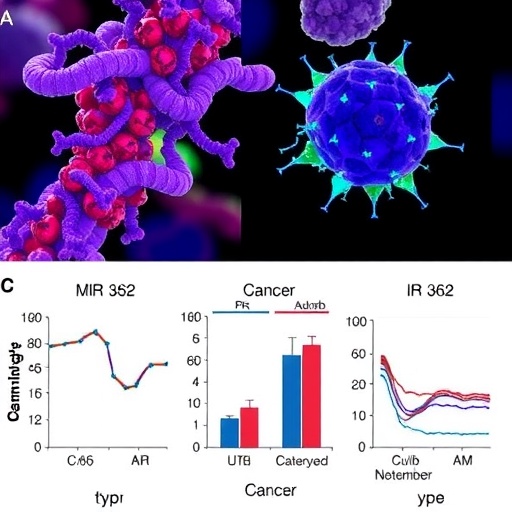
In the ever-evolving landscape of cancer research, microRNAs (miRNAs) continue to captivate scientists with their potent regulatory roles in gene expression and disease modulation. Among these small non-coding RNA molecules, miR-362 has recently emerged as a significant player with intriguing implications across various cancer types. New comprehensive research sheds light on the multifaceted roles of miR-362, unraveling its complex expression patterns and functional dynamics that may revolutionize our understanding of tumorigenesis and, consequently, cancer therapy.
MicroRNAs, typically 20-24 nucleotides long, orchestrate post-transcriptional gene regulation by binding to messenger RNA (mRNA) targets, leading to mRNA degradation or translational repression. miR-362, which belongs to this critical class of gene silencers, has been observed to exhibit dysregulated expression in numerous malignancies. This dysregulation can manifest as either oncogenic or tumor-suppressive functions, contingent on the cancer context, cellular environment, and interacting molecular pathways.
Intriguingly, miR-362’s dualistic nature adds a layer of complexity to cancer biology. In some malignancies, elevated levels of miR-362 correlate with enhanced proliferation, invasion, and metastasis, suggesting an oncogenic role. Conversely, in other cancer types, miR-362 expression is suppressed, leading to unchecked growth and resistance to apoptosis, which earmarks its tumor-suppressive capacities. This paradoxical behavior underscores the necessity for nuanced, context-dependent interpretations when considering miR-362 as a biomarker or therapeutic target.
.adsslot_HJuWYTedGO{width:728px !important;height:90px !important;}
@media(max-width:1199px){ .adsslot_HJuWYTedGO{width:468px !important;height:60px !important;}
}
@media(max-width:767px){ .adsslot_HJuWYTedGO{width:320px !important;height:50px !important;}
}
ADVERTISEMENT
One pivotal insight concerns miR-362’s participation in modulating critical signaling cascades known to influence cell cycle progression, apoptosis, epithelial-mesenchymal transition (EMT), and metastasis. For instance, miR-362 targets genes within the Wnt/β-catenin signaling pathway, which is pivotal in maintaining cellular homeostasis and driving oncogenic transformation when aberrantly activated. By fine-tuning key components of this pathway, miR-362 either fosters or restrains malignant phenotypes, highlighting its versatile regulatory potential.
Beyond Wnt signaling, miR-362 also interfaces with the PI3K/AKT/mTOR axis – a central hub governing cell survival, metabolism, and immune evasion. Aberrant activation of this pathway is characteristic of numerous cancers, and miR-362 can exert suppressive effects by targeting upstream or downstream effectors, thereby sensitizing cancer cells to apoptosis and inhibiting metastatic dissemination. This positions miR-362 not merely as a passive marker but as an active molecular switch with therapeutic ramifications.
Additionally, emerging evidence implicates miR-362 in the regulation of oxidative stress responses and DNA damage repair mechanisms, both critical factors influencing cancer cell adaptability and resistance to therapy. By modulating genes involved in reactive oxygen species (ROS) detoxification and double-strand break repair, miR-362 can impact genomic stability, which in turn affects the aggressiveness and treatment outcomes of tumors such as hepatocellular carcinoma and non-small cell lung cancer.
Recent studies have also spotlighted the interplay between miR-362 and the tumor microenvironment (TME). The TME, comprising immune cells, stromal cells, extracellular matrix, and soluble factors, plays a decisive role in tumor progression and therapeutic resistance. miR-362 influences the crosstalk within this microenvironment by regulating cytokine expression and immune checkpoint molecules, which may alter immune surveillance and facilitate tumor evasion from host defenses. Such findings suggest that manipulating miR-362 levels could enhance immunotherapeutic strategies.
Investigations employing high-throughput sequencing and bioinformatics analyses have mapped a comprehensive network of miR-362 target genes implicated in cancer hallmarks. These integrative studies provide invaluable resources for further experimental validation and therapeutic exploitation. For example, researchers have identified potential feedback loops where miR-362 regulates transcription factors that, in turn, influence miR-362 expression itself, creating intricate regulatory circuits that maintain cellular equilibrium or drive cancerous transformation.
One of the most promising aspects of miR-362 research lies in its diagnostic and prognostic utilities. Variations in miR-362 expression profiles can serve as minimally invasive biomarkers detectable in patient blood, urine, or other bodily fluids. Early detection of abnormal miR-362 levels might enable prompt intervention and personalized treatment regimens, significantly improving survival rates. Furthermore, miR-362 signatures could predict responsiveness to chemotherapy, radiotherapy, or targeted agents, facilitating precision oncology.
Despite the burgeoning interest, challenges remain in harnessing miR-362 for clinical application. The context-dependent roles necessitate thorough characterization in diverse populations and tumor types to avoid unintended consequences. Delivery methods for miR-362 mimics or inhibitors also require optimization to ensure specificity, stability, and minimal off-target effects. Nanoparticle-based systems and viral vectors are under active investigation to surmount these hurdles, potentially transforming miR-362 from bench to bedside.
Moreover, the integration of miR-362 profiling with other molecular markers and omics data sets may yield composite biomarkers with superior predictive power. Multi-modal approaches combining genomics, transcriptomics, proteomics, and metabolomics hold great promise to elucidate the comprehensive impact of miR-362 dysregulation on cancer biology. Such holistic insights will strengthen the foundation for novel combination therapies targeting multiple axes of tumor survival.
In summary, miR-362 occupies an increasingly prominent role as a molecular lynchpin in cancer pathogenesis, modulating critical pathways that dictate tumor growth, metastasis, and treatment resistance. The expanding evidence base underscores its value as both a biological beacon illuminating cancer mechanisms and a potential target for innovative therapeutics. As research continues to unravel the nuanced functionalities of miR-362, it heralds a new frontier in cancer biology that may pave the way for more effective diagnostics and personalized medicine strategies.
Given the pace of current discoveries, it is conceivable that future therapeutics will incorporate miR-362 modulation to reprogram aberrant cellular networks, enhance anti-cancer immune responses, and overcome resistance phenomena. This could markedly shift the paradigm in cancer treatment, transforming prognosis and quality of life for millions of patients worldwide. Continued interdisciplinary collaboration will be crucial to fully decode and exploit the promising potential contained within this tiny yet mighty RNA molecule.
Subject of Research: miR-362 expression and function across various cancer types
Article Title: The emerging role of miR-362 in cancer: expression and function across different cancer types
Article References:
Younis, S.M.D., Shareef, A., Baldaniya, L. et al. The emerging role of miR-362 in cancer: expression and function across different cancer types. Med Oncol 42, 380 (2025). https://doi.org/10.1007/s12032-025-02900-4
Image Credits: AI Generated
Tags: complexities of microRNA roles across cancer typescontext-dependent cancer biologydysregulated microRNA expression in malignanciesexpression patterns of miR-362implications of miR-362 in cancer therapymicroRNA interactions in tumorigenesismiR-362 and cellular environmentsmiR-362 in cancer researchoncogenic functions of miR-362post-transcriptional gene regulation mechanismsroles of microRNAs in tumorstumor-suppressive properties of miR-362





